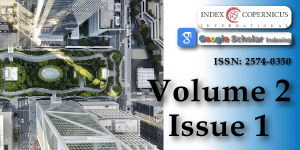Effect of cement solidification on strength and leaching properties of Heavy Metals Contaminated Soil
Main Article Content
Abstract
This study investigated the effect of Portland cement on stabilization of heavy metal contaminated clayey soils that may give range of geo environemntal benefits. The absolute concentration of heavy metals: Lead (Pb), Zinc (Zn), Chromium (Cr), Cadmium (Cd) and Copper (Cu) were measured using an inductively coupled plasma atomic emission spectroscopy (ICP-AES). A series of laboratory scale experiments such as unconfined compression test (UCT), pH test and synthetic precipitation leaching procedure (SPLP) were performed to study the effects of curing time and cement content on the unconfined compressive strength (UCS) and leaching characteristics of heavy metals. According to results, excessive concentration of heavy metals are present in the topsoil of Shanghai Jiao Tong University (SJTU) among which Pb, Zn and Cd were most prominent. Other test results showed that the dry density of both C4 and C8 soil samples increases with curing time. Similarly the compressive strength (qu)of C4 and C8 samples at 21 d of curing increases by 40% (113 kPa-288 kPa) and 15% (745kPa-864 kPa) respectively, as compared to the 7 d of curing. Besides, the test results showed a prominent decrease in the leached concentration of heavy metals with increasing curing time.
Article Details
Copyright (c) 2018 Jaffar STA, et al.

This work is licensed under a Creative Commons Attribution 4.0 International License.
García-Carmona M, Romero-Freire A, Aragón MS, Garzón FJM, Peinado FJM. Evaluation of remediation techniques in soils affected by residual contamination with heavy metals and arsenic. J Environ Manage. 2017; 191: 228-236. Ref.: https://tinyurl.com/yb3274pn
Islam S, Ahmed K, Habibullah AM, Masunaga S. Potential ecological risk of hazardous elements in different land-use urban soils of Bangladesh. Sci Total Environ. 2015; 512-513: 94-102. Ref.: https://tinyurl.com/yb86pyvp
Tang X, Li Q, Wu M, Lin L, Scholz M. Review of remediation practices regarding cadmium-enriched farmland soil with particular reference to China. J Environ Manage. 2016; 181: 646-662. Ref.: https://tinyurl.com/ydyhq42c
Xie J, Li F. Overview of the current situation on brownfield remediation and redevelopment in China. 2010. Ref.: https://tinyurl.com/y8fjepbf
Evanko CR, Dzombak DA. Remediation of metals-contaminated soils and groundwater: Ground-water remediation technologies analysis center Pittsburg. USA. 1997. Ref.: https://tinyurl.com/y7e8bvx4
Zhong Sq. Soil contamination and remediation in the diggings area. Resource Development & Market. 2007; 6: 532-534.
Jaffar STA, Luo F, Ye R, Younas H, Hu Xf, et al. The Extent of Heavy Metal Pollution and Their Potential Health Risk in Topsoils of the Massively Urbanized District of Shanghai. Arch Environ Contam Toxicol. 2017; 73: 362-376. Ref.: https://tinyurl.com/y7jys46a
Jaffar STA, Chen Lz, Younas H, Ahmad N. Heavy metals pollution assessment in correlation with magnetic susceptibility in topsoils of Shanghai. Environmental Earth Sciences. 2017; 76: 277. Ref.: https://tinyurl.com/y93lhf55
Khalid S, Shahid M, Niazi NK, Murtaza B, Bibi I, et al. A comparison of technologies for remediation of heavy metal contaminated soils. Journal of Geochemical Exploration. 2017; 182: 247-268. Ref.: https://tinyurl.com/ybhj98ya
Zhu W, Li L, Lin C. Biochemical effects on permeability of solidified sludge. Yantu Lixue(Rock and Soil Mechanics). 2006; 27: 933-938. Ref.: https://tinyurl.com/y8yeukv3
Liu YG, Li X, Zeng GM, Huang BR, Zhang HZ. Electrokinetics removal of lead from lead-contaminated red soils. Transactions of the Nonferrous Metals Society of China. 2003; 13: 1475-1478.
Zhang T, Cai G, Liu S. Assessment of mechanical properties in recycled lignin-stabilized silty soil as base fill material. Journal of Cleaner Production, 2018; 172: 1788-1799. Ref.: https://tinyurl.com/ya4lexyp
Riley BJ, Vienna JD, Strachan DM, McCloy JS, Jerden JL. Materials and processes for the effective capture and immobilization of radioiodine: a review. Journal of Nuclear Materials. 2016; 470: 307-326. Ref.: https://tinyurl.com/yaszzh6a
Terashi M. Fundamental properties of lime and cement treated soils. Report of PHRI. 1980; 19: 33-62. Ref.: https://tinyurl.com/ya4mopca
Minocha A, Jain N, Verma C. Effect of inorganic materials on the solidification of heavy metal sludge. Cement and Concrete Research. 2003; 33: 1695-1701. Ref.: https://tinyurl.com/yaevkaxm
Goodarzi AR, Movahedrad M. Stabilization/solidification of zinc-contaminated kaolin clay using ground granulated blast-furnace slag and different types of activators. Applied Geochemistry. 2017; 81: 155-165. Ref.: https://tinyurl.com/ybt5t64n
Lee D. Formation of leadhillite and calcium lead silicate hydrate (C–Pb–S–H) in the solidification/stabilization of lead contaminants. Chemosphere. 2007; 66: 1727-1733. Ref.: https://tinyurl.com/y7huj2q6
Stepanova I, Lukina L, Svatovskaya L, Sychev M. Hardening of cement pastes in presence of chlorides of 3d elements. Journal of Applied Chemistry of the USSR. 1981; 54: 885-888.
Zhang Hq, Yang Yy, Yi Yc. Effect of sulfate erosion on strength and leaching characteristic of stabilized heavy metal contaminated red clay. Transactions of Nonferrous Metals Society of China. 2017; 27: 666-675. Ref.: https://tinyurl.com/y969c9wu
Gupta A, Arora VK, Biswas S. Contaminated dredged soil stabilization using cement and bottom ash for use as highway subgrade fill. International Journal of Geo-Engineering. 2017; 8: 20. Ref.: https://tinyurl.com/yakk9hwv
Hu XF, Su Y, Ye R, Li XQ, Zhang GL. Magnetic properties of the urban soils in Shanghai and their environmental implications. Catena. 2007; 70: 428-436. Ref.: https://tinyurl.com/y8lnvftc
Wei B, Yang L. A review of heavy metal contaminations in urban soils, urban road dusts and agricultural soils from China. Microchemical Journal. 2010; 94: 99-107. Ref.: https://tinyurl.com/yaxp8wma
Du YJ, Wei ML, Jin F, Liu ZB. Stress–strain relation and strength characteristics of cement treated zinc-contaminated clay. Engineering Geology. 2013; 167: 20-26. Ref.: https://tinyurl.com/yb3tjovm
Yang YY, Wu HL, Du YJ. Strength and leaching characteristics of heavy metal contaminated soils solidified by cement. J Residuals Science & Technology. 2014; 11: 91-98.
Estabragh AR, Kholoosi M, Ghaziani F, Javadi AA. Mechanical and Leaching Behavior of a Stabilized and Solidified Anthracene-Contaminated Soil. Journal of Environmental Engineering. 2018; 144: 04017098. Ref.: https://tinyurl.com/y7v5w5bg
Yan-jun D, Ning-jun J, Le W, Ming-li W. Strength and microstructure characteristics of cement-based solidified/stabilized zinc-contaminated kaolin. Chinese Journal of Geotechnical Engineering. 2012; 11: 2114-2120. Ref.: https://tinyurl.com/y9yssm3g
Wang YS, Dai JG, Wang L, Tsang DCW, Poon CS. Influence of lead on stabilization/solidification by ordinary Portland cement and magnesium phosphate cement. Chemosphere. 2018; 190: 90-96. Ref.: https://tinyurl.com/y9nt3tex
Gougar MLD, Scheetz BE, Roy DM. Ettringite and C-S-H portland cement phases for waste ion immobilization: A review. Waste Management. 1996; 16: 295-303. Ref.: https://tinyurl.com/yabmmohy

